Editorial Cartoon by Bob Englehart
/
by Eric Jackson, PhD and Donald Larsen, PE
In Connecticut, as in many other snow belt states, the state Department of Transportation (CTDOT) as well as local Public Works Departments (DPWs) can suddenly be thrust into the spotlight (or the hot seat) when winter storms hit, particularly when driving conditions deteriorate. Our daily exposure to lightning fast activities and information, which allow us to assess situations a nd form opinions rapidly have altered our expectations.
nd form opinions rapidly have altered our expectations.
Interestingly, as little as ten years ago, when a winter storm would make travel hazardous and place our busy lives on hold, we seemed able to adapt, maybe wait a day, adjust and move on. Today’s society has little patience for travel delays and the “privilege” to travel is now seen as more of a right.
Fortunately, the CTDOT does not view this challenge as insurmountable and has used foresight and innovation to keep winter travel as safe as possible. Since the winter sea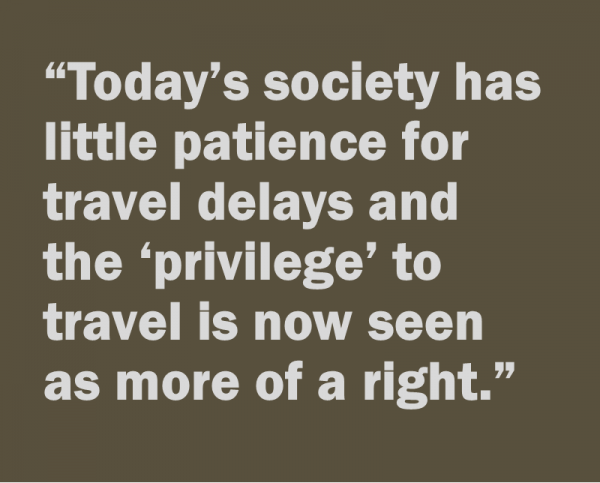 son of 2006/2007 CTDOT has changed the way winter maintenance is performed. They have discontinued the use of abrasives (such as sand) and phased in methods known as ‘anti-icing’ strategies [1]. These strategies have been honed and polished continually over the past ten years.
son of 2006/2007 CTDOT has changed the way winter maintenance is performed. They have discontinued the use of abrasives (such as sand) and phased in methods known as ‘anti-icing’ strategies [1]. These strategies have been honed and polished continually over the past ten years.
The Connecticut Academy of Science and Engineering (CASE) prepared a report for the Connecticut General Assembly in 2015 that evaluated winter maintenance strategies employed at CTDOT. This study reviewed CTDOT’s anti-icing effects on safety, the environment, and corrosion of vehicles and highway infrastructure. The entire report can be found at http://www.ctcase.org/reports/ [2]. The safety implications of these changes were analyzed using the Connecticut Crash Data Repository (CTCDR), a motor vehicle crash database housed at the University of Connecticut.
An analysis of vehicle crashes over thirteen winter seasons, 1999 to 2013, was conducted to try and evaluate the impact of anti-icing on safety (see chart). A comparison of crashes, specifically for state-maintained roads during winter seasons, indicates that injuries declined by 19.2%, on average, since anti-icing strategies were implemented. When crashes on snow/slush or ice surface conditions were examined the average reduction in crashes with nonfatal injuries was an even more dramatic, 33.5%. 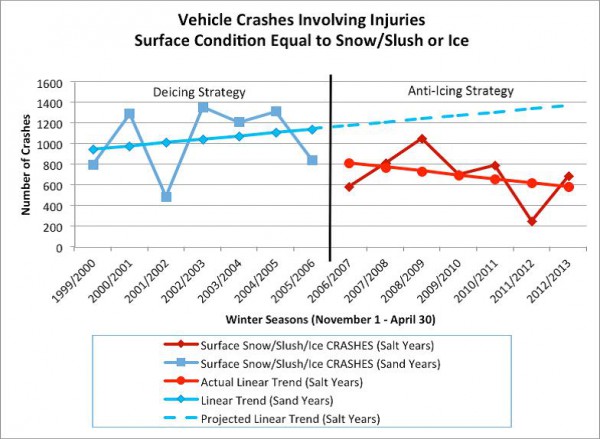
CHART: Motor vehicle crashes involving nonfatal injuries with pavement surface condition equal to snow/slush or ice on Connecticut state-maintained roadways.
The reduction in the number of motor vehicle crashes with nonfatal injuries is a significant finding because according to a study by Qiu et al at the University of Iowa the rate of crashes on snow can be 84% higher than on dry pavement [3]. With an estimated cost in 2010 (from the National Highway Traffic Safety Administration) of $276,000 per non-incapacitating injury, [4] society- including everyone that travels - benefits from this significant reduction in injurious crashes.
Between 2006 and 2013, there was a reduction of 2,449 crashes with nonfatal injuries on Connecticut state-maintained roadways during snow/slush or ice conditions. This calculates out to a cost savings of approximately $676 million.*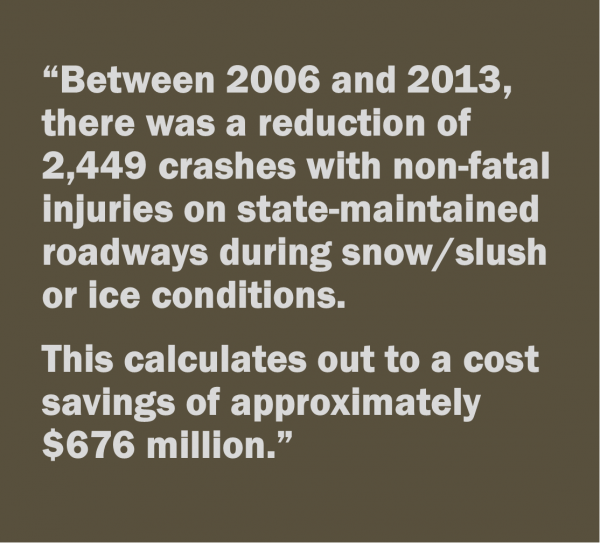
Other ongoing research throughout the world shows that plowing is still the most cost effective way to clear the roadways of snow and ice. Abrasives such as sand, grit or stone dust do not remove the snow or ice, and only delay the inevitable need for removal or melting.
However, the anti-icing techniques – the scientific application of deicing chemicals such as salt and other materials - provide a very important aid to snow/ice removal operations, preventing ice and snow from bonding to paved surfaces. With anti-icing, the time period with snow covered roads – which are those critical times when crashes are most likely to occur - is also reduced.
From the estimated savings shown, it is important that CTDOT and the local municipal DPWs continue to improve winter maintenance by employing state-of-the-art equipment for chemical applications, timely snow and ice removal, and using weather monitoring stations as well as advanced weather prediction services and models. It appears that from the safety benefits alone, the continued expenditures made on winter maintenance have paid off. Reducing the negative economic impact that results when people and goods don’t move is another benefit.
The CTCDR is available to anyone wishing to view motor vehicle crash statistics in Connecticut, for any type of crash, under any road conditions. Connecticut is one of the few states that maintains a publicly accessible crash database. It is highly recommended that if you have an interest in crash data, visit http://ctcrash.uconn.edu/ [5].
____________________________________
Dr. Eric Jackson is an Associate Research Professor in the School of Engineering at the University of Connecticut and is Director of the Connecticut Transportation Safety Research Center. Donald Larsen PE, is a Temporary University Specialist at the Connecticut Transportation Institute at UConn and former Supervising Engineer with the Connecticut Department of Transportation
PERSPECTIVE commentaries by contributing writers appear each Sunday on Connecticut by the Numbers.
LAST WEEK: Do Community College Students Go Begging?
______________
[1] CTDOT Staff, An Overview of Snow and Ice Control Operations on State Highways in Connecticut, Office of Maintenance, Bureau of Highway Operations, Connecticut Department of Transportation, Newington, CT, June 2015.
[2] Mahoney, J., D. Larsen, E. Jackson, K. Wille, T. Vadas, and S. Zinke, Winter Highway Maintenance Operations: Connecticut, Publication CT-2289-F-15-1, CTDOT, Connecticut Academy of Science and Engineering, July 2015. http://www.ctcase.org/reports/WinterHighway2015/winter-highway-2015.pdf
[3] Qiu, L., and W. Nixon, Effects of Adverse Weather on Traffic Crashes, Transportation Research Record: Journal of the Transportation Research Board, No. 2055, Transportation Research Board of the National Academies, Washington, D.C., 2008, pp. 139-146.
[4] Blincoe, L. J., Miller, T. R., Zaloshnja, E., & Lawrence, B. A., The Economic and Societal Impact of Motor Vehicle Crashes, 2010, National Highway Traffic Safety Administration, USDOT, Washington, DC, Report No. DOT HS 812 013, May 2014, (rev. 2015, May).
[5] Connecticut Crash Data Repository, Connecticut Transportation Institute, University of Connecticut, Storrs, CT. Website. http://ctcrash.uconn.edu/ (Accessed May 5, 2016).
* For purposes of this calculation, each crash was arbitrarily assigned one non-incapacitating injury.
This article is based on a study conducted by the Connecticut Academy of Science and Engineering on behalf of the Connecticut Department of Transportation. Eric Jackson and Donald Larsen served as members of the Research Team from the Connecticut Transportation Institute at the University of Connecticut. Access the full study report, an executive summary, and briefing at http://www.ctcase.org/reports/index.html
by Endia DeCordova
A professor at Manchester Community College noticed that a student – typically a regular class attendee – had stopped coming. Efforts to contact the student ultimately revealed that she had given up on many of her goals, including her education, because of depression. Having her electricity turned off because she couldn’t afford the bill was the last straw.
A staff member at the college was approached by a student who asked to borrow a dollar for the vending machine. He had to remain on campus all day -- through an evening course -- and couldn’t afford to buy anything from the cafeteria.
One more anecdote involves a student who dropped out because of an inability to scrape up bus fare. That student relied on public transportation to get everywhere, including to class.
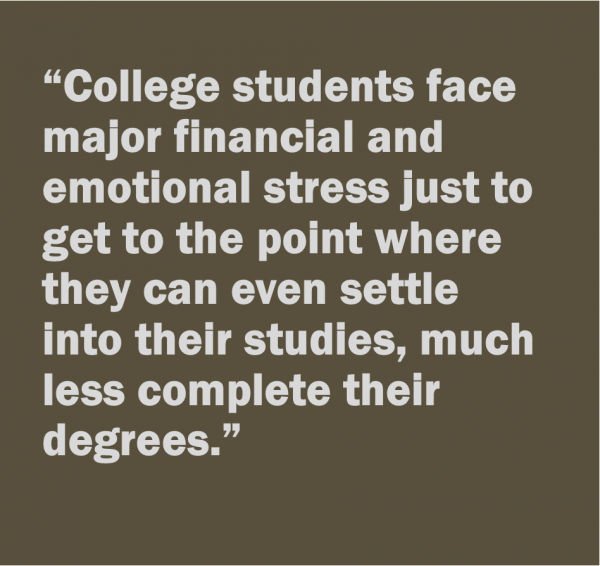 These are true stories. The names are omitted and details smoothed over for obvious reasons. But they really happened this spring at MCC. The image of the college student – not a care in the world – partying and protesting, cramming just in time to pass an exam, and simply marking time until graduation has never really been accurate. It is certainly far from the truth today. College students face major financial and emotional stress just to get to the point where they can even settle into their studies, much less complete their degrees.
These are true stories. The names are omitted and details smoothed over for obvious reasons. But they really happened this spring at MCC. The image of the college student – not a care in the world – partying and protesting, cramming just in time to pass an exam, and simply marking time until graduation has never really been accurate. It is certainly far from the truth today. College students face major financial and emotional stress just to get to the point where they can even settle into their studies, much less complete their degrees.
In fact, the story of the borrowed candy-bar dollar is especially heartbreaking as it makes clear how much of a hurdle food-insecurity is for an increasing number of college students. A February 2016 article in The Chronicle of Higher Education, “Students Shouldn’t Have to Choose Between Books and Food,” highlights the disturbing data on hunger among college students. According to a 2015 study by the Wisconsin HOPE Lab, 20 percent of community-college students were going hungry. Another, by City University of New York, found that 39 percent of its students were similarly at risk.
This underscores a major issue for college students nationally. How is it that higher ed creates poverty among people who are clearly working to improve their lives?
Rising costs of tuition, fees and books are easy to point to. At MCC, people are struggling to pay for higher education and after they enroll, often can’t follow through. For the spring 2016 term, nearly 900 students who applied to MCC paid their application fee but did not enroll. Another nearly 500 students enrolled but couldn’t complete their payments and were forced to drop out for lack of financial resources. Of those, many struggled to buy books or other class materials.
But the real issue is running just below the surface. Common sense tells us all that if you can’t afford to pay for something that is essentially a luxury – or a privilege, as many still view a college degree – you don’t buy it.
For many MCC students, not going to college is not an option. Their education is key to transformation – in many cases, moving them from zero hope to a promising future and a life of contributing to their families and their communities.
Yet as they forge ahead, they go begging for the basics. As the students above tragically did, they too often give up short of their goals. At the same time, public funds in Connecticut for higher ed are dropping.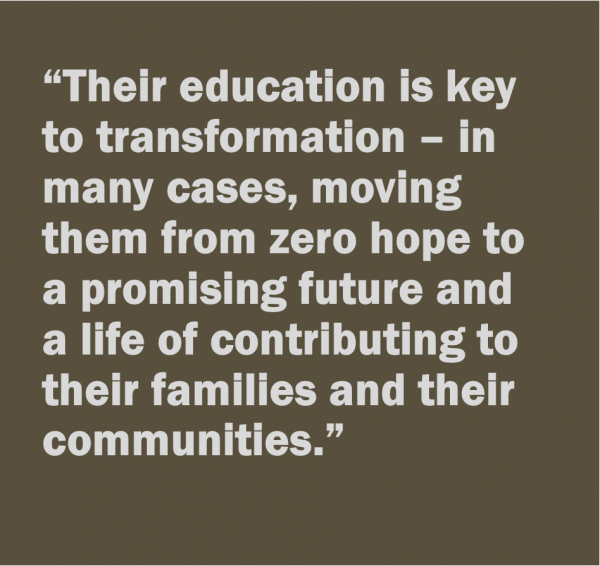
This is why MCC is working through its foundation to develop a retention and completion grant program. Like many community colleges nationwide, we are determined to support students who have delayed starting college or “stopped out” of college because of short-term financial distress.
We ask students to assume some of the risk connected with the funding so they remain vested in their futures, but these grants (not loans) are designed to help them pay for the books -- or the bus pass, the electricity, the food they need -- to keep going and to graduate or transfer.
A college education today is a necessity. No one should have to beg.
__________________
Endia DeCordova is Dean of Institutional Advancement and Community Engagement for Manchester Community College.
PERSPECTIVE commentaries by contributing writers appear each Sunday on Connecticut by the Numbers.
LAST WEEK: Face Your Fears - and the Editorial Board
by Paul Steinmetz
Even those of us who love our jobs dread some tasks that we can’t avoid. For many politicians, it’s the interview with the local newspaper’s editorial board. I imagine a lot of candidates will relive the scene many times: You sit across a conference room table from a handful of people, some of whom you have grown to loathe, and others you may not know. The editorial board is usually made up of the editorial page editor, the editor, maybe the publisher, and a reporter or two.
If you are an incumbent, the editorial page editor likely has written something biting and cruel about you in the past several months. You only talk to the editor when you call to complain about the editorial page editor. You may see the reporter frequently; he or she has repeatedly told you that the reporters have nothing to do with the editorials, and don’t know their content until they’re published. You aren’t positive that’s the truth. Nevertheless, you have convinced yourself this is a duty you must take on. If the newspaper endorses you, it might persuade some voters in your favor.
As the editor of a daily community paper, I sat on the editorial board for many election cycles. Unbeknownst to those running for office, I never prepared as well as I promised myself I would. And often they were stilted interviews because in the interest of fairness, we asked each candidate running for the same office the exact same questions, when it would have been much more interesting to get them talking on a personal level.
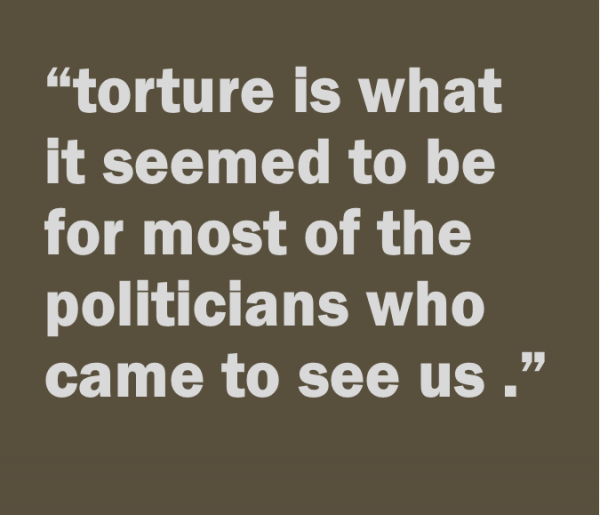 For example, one year a third-party candidate ran for mayor. He also hosted a local cable talk show and a couple of years earlier, in a rant against the newspaper and me, he had urged viewers to dump their household garbage at the foot of my driveway. No one did, and I decided finally not to torture him.
For example, one year a third-party candidate ran for mayor. He also hosted a local cable talk show and a couple of years earlier, in a rant against the newspaper and me, he had urged viewers to dump their household garbage at the foot of my driveway. No one did, and I decided finally not to torture him.
And torture is what it seemed to be for most of the politicians who came to see us. The most experienced wore a weary air or were angry and combative. John Rowland, when he was Connecticut’s governor, hated our editorials and our editorial page editor and he usually complained throughout the interview. (We usually endorsed him.)
One gentleman running for a seat as a state representative had no political experience and seemed terrified. He stammered, started to answer one way and then changed direction, and practically squeaked by the end of the session. I don’t recall any particularly tough questions; he had built it up in his mind that we were going to rip him apart, or ask him something he didn’t know. Admittedly, the editorial page editor was a little scary. She always did her homework and knew the issues. Her editorials routinely skewered politicians.
For the most part, journalists understand that they must see many sides of an issue, and their personal feelings are not to enter the equation. I know that sounds naïve to those outside the newsroom, but in my experience it was true. And the politicians who did best understood what we were trying to do and what, for the most part, they could expect.
After I left the paper a friend of mine who was running for re-election asked me to help him prepare for his upcoming editorial board interview. I suggested some of the issues the editors might bring up and some of the positions he had taken in the past couple of years that he would be criticized for. Then I pointed out he was not going to get the endorsement. He was a Republican and fairly conservative. The editor was unabashedly liberal. My friend’s opponent was a minority – and gay. “He’s their dream candidate,” I said. “They can’t pass this up.”
He laughed, sat back and acknowledged I was right. Later he said it was the most fun he had ever had at an editorial board interview.
When you admit that some parts of the job just aren’t as fun as others – but they still must be tackled – it is easier to address them with courage and even a sense of humor.
________________________________
Paul Steinmetz is director of Public Affairs & Community Relations at Western Connecticut State University. As the founder of Writing Associates, he consults on writing and media issues for businesses and individuals.
PERSPECTIVE commentaries by contributing writers appear each Sunday on Connecticut by the Numbers.
by Tom Wood The retirement party, it’s a familiar sight; we’ve all been to our fair share. Once you get past the cake, balloons, and bittersweet nostalgia you have to face the fact that you just lost a valued member of your management team. This is when many nonprofit organizations begin to address their succession planning. Even if it is only unspoken, there is a general consciousness that a retirement is coming, but when it comes to resignations there is usually a lack of any advanced noticed.
The effects of sudden turnover resonate strongest for nonprofit entities. For one, employees are driven by the mission and therefore tend to stay for a long time making them unwritten resources. In addition, everyone wears more than one hat so multiple aspects of the organization are affected. A few unplanned departures can have a great impact on multiple facets of the organization resulting in lost institutional knowledge. It also takes more time to replace a position as the skill set for many nonprofit organizations is program specific, which limits the pool of potential candidates.
So when is the best time to start thinking about succession planning? Like everything else in life, an ounce of prevention is worth a pound of cure. As cliché as it sounds, the key is to address succession planning before it ever becomes an issue. A process should be developed to identify and monitor management positions that are at risk. From there, you can take three simple steps to mitigate succession related issues: 1) update your procedures manual annually, 2) cross train staff, and 3) develop from within.
Every nonprofit has a handful of individuals who have been around forever. They are the ones who know everything. The first step to proper succession planning is to document what they do. It sounds simple, but how often does your organization update its employee handbook or procedures manual? Make sure that the manual is reviewed by the person actually performing the duties. Having a current procedures manual will make sure that institutional knowledge isn’t lost.
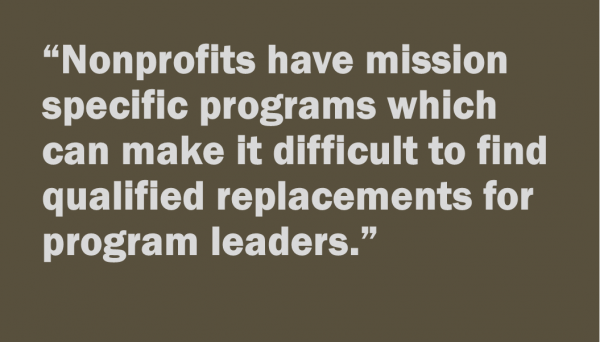 Once your procedures are up to date, start cross training your staff. Not only will it be helpful in the event of unforeseen turnover, but it is an important internal control. Cross training is a temporary solution, but it can buy you time to find the perfect candidate.
Once your procedures are up to date, start cross training your staff. Not only will it be helpful in the event of unforeseen turnover, but it is an important internal control. Cross training is a temporary solution, but it can buy you time to find the perfect candidate.
Nonprofits have mission specific programs which can make it difficult to find qualified replacements for program leaders. Often times, very specific job requirements including years of experience and advanced degrees limit the candidate pool. Now, you could hire an expensive headhunter who might come up with a handful of so-so replacements, but there is another option, albeit more long-term: hire from within. Identify potential leaders within your organization and then create a long term development plan. Unlike outside recruits, internal hires already understand the organization, fit in with the culture, and are passionate about the mission.
Senior management isn’t the only group that can benefit from succession planning. A healthy nonprofit is usually the result of an involved board of directors; a strong board takes time to develop and needs to be maintained. Typically, most nonprofit boards have a nominating or governance committee which are charged with finding and vetting future directors. Term limits and classes will keep the board fresh and prevent all the responsibility falling on a few individuals.
So the next time your nonprofit has a retirement party, enjoy a piece of cake and don’t worry because you’ll be ready.
____________________________________
Tom Wood is an audit manager with Whittlesey & Hadley, P.C. He specializes in audits of nonprofit organizations. Whittlesey & Hadley, P.C. is a leading, regional provider of accounting, financial, business and technology consulting services, headquartered in Hartford, with offices in Hamden, CT and Holyoke, MA.
PERSPECTIVE commentaries by contributing writers appear each Sunday on Connecticut by the Numbers.
LAST WEEK: Driven by Discovery
by Dr. France A. Córdova You deserve hearty congratulations for this remarkable achievement. This is an important milestone – you now have a degree, and all the expertise and knowledge that slip of paper implies, and you are charged with venturing out into a big world – full of possibilities. After all, you are ENGINEERS – you design and make things. The world is open to your creativity.
This is also a particularly special milestone for your University, since you are UConn Engineering's centennial graduating class. You join a long lineage of top-flight engineers, including the man this very arena is named after, Harry A. Gampel.
I'm not sure that Harry, a 1943 civil engineering major, knew what a powerhouse the Huskies would become when he pledged to help build this arena. But I guarantee he would be disappointed if I did not also congratulate the men's and women's basketball teams on another spectacular year.
Gampel Pavilion has become a home of excellence: the men's team with another appearance in the national tournament, and the women's team undefeated for a record-breaking fourth year. For some of you, they have been national champions every year of your time at UConn Engineering! It may seem inevitable at this point, but I can promise you nothing about being a champion is inevitable.
It takes teamwork and dedication, early mornings and late nights, risk and redemption. It takes, in other words, the same qualities you will have to demonstrate as engineers.
 Nothing is inevitable about being a scientist or an engineer – and that's one of the most frustrating and wonderful things about our chosen field. Experiments fail and hypotheses crumble. Data might not be as neat, as revealing as you'd hoped, technology might break at the worst moment, you might spend years chasing a question only to have the answer continually slip away. But then there are wonderful moments of discovery -- and I promise you the euphoria makes up for all the frustration.
Nothing is inevitable about being a scientist or an engineer – and that's one of the most frustrating and wonderful things about our chosen field. Experiments fail and hypotheses crumble. Data might not be as neat, as revealing as you'd hoped, technology might break at the worst moment, you might spend years chasing a question only to have the answer continually slip away. But then there are wonderful moments of discovery -- and I promise you the euphoria makes up for all the frustration.
I am driven by discovery. As a young girl, I wanted to be a detective. Parents – think Nancy Drew – I wanted to be Nancy. I love a difficult problem, putting the puzzle pieces together. This passion drew me to astronomy, a field with lots of Big Mysterious Questions: What are the origins of stars? Does life exist on distant planets, and what might it look like? Surely not like you or me! What is the nature of 95% of the mass energy content of the universe? It turns out that we know so little…
It took me a while to actually get to astronomy – the path of a scientist or engineer is always more of a random walk than people think – but once I got my own science degree, my own entry into the "real world," all I wanted to do was be a cosmic detective.
As a Ph.D. student I studied x-ray astronomy, then a nascent field. I used a high-energy satellite, controlled by the Goddard Space Flight Center, to collect data on close binary stars. One night I got word that one of these stars had gone into visual outburst. I ran to my thesis advisor and told him we must stop the satellite scanning and point it directly at the star.
My advisor asked me if I was absolutely sure I would detect something extraordinary – after all, pointing that satellite was an expensive proposition. I took a deep breath, crossed my fingers behind my back and said without pause, "Absolutely."
Graduates, remember this – because one day you will be asked the question by your boss, “Are you sure [you want to do that]?” You’ll have to rely on all your reading, your knowledge, your experience, and your intuition before you respond. I said “Absolutely” and I was rewarded. When I received my data, there it was, a beautiful signal: the first-ever detection of rapid x-ray pulsations from a collapsed star accreting matter from a normal star like our Sun.
It was a message that had traveled thousands of light years, through space and time, to me. That discovery remains one of the highlights of my life.
You will make your own discoveries, suffer your own frustrations. Prepare for them, as best you can. UConn has already done an exemplary job of preparing you for the hard work it takes to be a discoverer, an inventor, a champion.
You are graduating at an exciting time in engineering. The field is becoming increasingly intertwined with other disciplines. STEM fields are melding together, creating a rich breeding ground for new discoveries and new inventions. The grand challenges of our time – building smarter cities, improving access to clean water, harnessing sustainable energy – will be tackled by engineers like you, working in concert with designers, social scientists or computer scientists or biologists. A team of new discoverers and inventors.
For any team, the road to success is not an easy one. From my own experiences, ones that led me to become head of NSF, I have learned this: find great people to be a part of your team, those you can depend on. Find a mentor/coach who will continue to teach you how to navigate high-risk and high-reward career plays. Find someone who will become your number one fan in your personal cheering section. And find worthy opponents – those real and abstract – who challenge you, keep you guessing, and drive your passion.
As I close my remarks I want to leave you with a quote from my virtual mentor, Einstein. … Actually, my favorite quote from him is “Gravity cannot be held responsible for people falling in love.” But that really has nothing to do with my narrative today, so, I’ll leave you with this one instead: Einstein said "I have no special talents. I am only passionately curious."
I encourage you to always be passionately curious, for this leads to discovery, to invention. Know that you are in control: technology will continue to shape our lives, but you – our future engineers – can shape technology to better human life. We are counting on you!
______________________________
Dr. France A. Córdova is Director of the National Science Foundation. These remarks were delivered to the graduates of the University of Connecticut School of Engineering at commencement ceremonies on May 7, 2016.
Dr. Córdova, was sworn in as director of the National Science Foundation (NSF) on March 31, 2014. Nominated by President Barack Obama to head the $7.2-billion independent federal agency, she was confirmed by the United States Senate. Córdova is president emerita of Purdue University, where she served as president from 2007 to 2012. Previously, she led the University of California, Riverside, as chancellor and was a distinguished professor of physics and astronomy. From 1993 to 1996, Córdova served as NASA's chief scientist.
PERSPECTIVE commentaries by contributing writers appear each Sunday on Connecticut by the Numbers.
LAST WEEK: An Intervention in History





© 2025 Connecticut By The Numbers [TM] 557 Prospect Avenue - 1st Floor, West Hartford, CT 06105
Designed by RDK Design & Photography